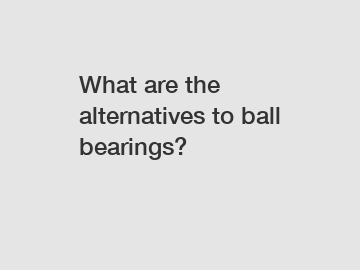What are the alternatives to ball bearings?
What are the alternatives to ball bearings?
Ball bearings have long been a crucial component in various mechanical systems, providing support and reducing friction between moving parts. However, as technology advances and industries continuously seek innovative solutions, alternative options to ball bearings have emerged. In this article, we will explore some of these alternatives and examine their potential benefits and drawbacks.
1. Fluid Bearings:

Fluid bearings, also known as hydrodynamic bearings, operate on the principle of a thin layer of fluid, typically oil or air, separating the moving parts. This reduces friction and allows smooth movement. Fluid bearings offer numerous advantages, including high load capacity, excellent shock absorption, and reduced noise. Moreover, they require minimal maintenance due to the absence of mechanical elements that can wear out. However, fluid bearings might not be suitable for certain high-speed applications due to potential fluid film instabilities and energy losses.
2. Magnetic Bearings:
Magnetic bearings use magnetic fields to suspend and guide the rotating shafts without physical contact. These bearings offer several benefits, such as virtually zero friction, increased efficiency, and reduced maintenance requirements. Additionally, magnetic bearings can operate in extreme environments, including high temperatures and vacuum conditions. However, they are often more expensive and complex to implement compared to traditional ball bearings.
3. Air Bearings:
Air bearings, also known as aerodynamic bearings, use a thin layer of compressed air to support and align the moving parts without direct contact. These bearings offer several advantages, such as minimal friction, high-speed capabilities, and excellent precision. Air bearings are commonly used in industries where high accuracy and speed are required, like semiconductor manufacturing and precision machining. However, air bearings may consume a significant amount of compressed air and require a constant and clean air supply.
4. Roller Bearings:
Roller bearings are similar to ball bearings but utilize cylindrical rollers instead of balls to distribute the load. This design allows for higher load capacities and better resistance to shock and vibration. Roller bearings are widely used in heavy-duty applications where the radial and axial loads are substantial, such as conveyors and automotive wheel bearings. However, compared to ball bearings, roller bearings may exhibit higher friction and limit rotational speed.
In conclusion, the alternatives to ball bearings offer diverse solutions depending on the specific requirements of the application. Fluid bearings provide excellent load capacity and shock absorption while requiring minimal maintenance. Magnetic bearings offer extremely low friction, high efficiency, and can operate in extreme conditions. Air bearings excel in high-speed and high-precision applications, although they consume compressed air. Roller bearings, on the other hand, offer enhanced load capacity and durability, but at the expense of increased friction. Ultimately, the choice of the most suitable alternative to ball bearings depends on the specific needs of the machinery or system involved, taking into account factors such as load requirements, operating conditions, and cost considerations.
For more Automotive hydraulic release bearing ME539936, Auto parts front hub unit bearing 3880A018, Industrial Machinery Bearing Roller Bearing Manufacturersinformation, please contact us. We will provide professional answers.

Comments